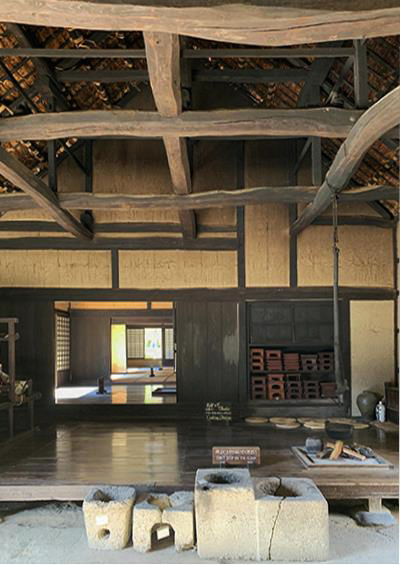

日本の民家では天井を張るのは、歴史的にはまだ数百年なのだという。
基本的には家というのは、外界との間を結界する、
内部空間を生み出すことがその機縁なのでしょう。
そのために柱を立て地盤面を仕切り、屋根を掛けることが人間社会で先行した。
ある程度の文化段階に至って、そういう「巣作り」がイキモノとしての人間に
普遍的に進化を見せてきたと言えるのでしょう。
次の段階で、壁をどう作るのかというテーマが生起して、
木を張ったり、土壁を造作したりした。
人間の体温維持のための暖房は、平行的に随伴したけれど、
ある段階までは、その家の周辺で採取されるバイオマス・薪が役立てられ
このことは、それこそ定住以前からの人類伝統だった。
この暖房エネルギーに革命が起こるのは、エネルギー革命が進行した
日本で言えば明治期以降なのでしょう、高々150年程度。
薪を焚いて得られる暖房の火力というのはどれくらいのモノであるのか、
たしかそういった研究もあったように思うけれど、定かではない。
・・・と書き終わったときに、三浦秀一東北芸工大教授の
以下のFacebook投稿に遭遇したので、引用します(許諾済み)。
〜冬に容量5kWh蓄電池でエアコンの暖房を動かせるのは3~4時間。
電気のいらない薪ストーブでいうならば、薪3~4本分の暖房熱量です。
100万円ぐらいする蓄電池が薪3~4本分の力しかないのです。
少し電気を使いますが、ペレットだと3.7kg。
薪やペレットといった木のエネルギー貯蔵力がいかに大きいかが分かる。
エアコンを蓄電池で動かそうなどと考えない方がいいと言うことでもある。
震災の時、薪ストーブは大活躍でした。その後蓄電池は普及してきましたが、
今も薪を超えるものではありません。
拙著「研究者が本気で建てた ゼロエネルギー住宅」に詳述。〜引用以上。
しかし写真の、この気積空間では圧倒的に非力であったことは疑いがない。
日本では貴族住宅などでこうした木造架構空間に「天井」が張られてきた。
その初期には、いごこちの優位性が根拠だったに違いない。
床には畳がしつらえられ壁には土塗り壁がほどこされ、
そして天井には「木の板」が張られるようになる、という進化プロセスは
やはりどう考えても「居住性能」がその目的根拠だったと思われる。
写真のような巨大気積の空間の暖房火力として用意されているのは
手前側の石をくり抜いたかまど類と、囲炉裏。
この信州・佐久の家、冬期には容赦のない冷気が襲ってくる地域環境。
最低気温は当然零下であろうし、場合によっては零下10度前後も考えられる。
〜寝ていると布団の口のまわりが凍ってしまうので、ホオッカムリ(頭と顔を布で
くるむこと)をして寝ました。吹雪の日は屋根の煙り抜け部分から
雪が吹き込んできた。〜という状況。
こういった造作自体は北海道の初期規格住宅といえる屯田兵屋でも同様だから、
ごく最近まで天井のない空間で日本人は暮らしていたと言えるのでしょう。
そう考えてくると、国防的な理由から開拓が進んだ北海道が
その厳しい気候条件を提供して、ようやく知恵と工夫をまとめ上げた
「高断熱高気密」は、歴史的な進化の契機だったといえるのでしょう。
ただ一方で、この広大な屋根の下の空間は、
ノスタルジックであり、また美的にも魅力的だともいえる。
天井断熱からさらに屋根断熱へと至っていく動機でもあるのかも知れません。
English version⬇
[Ceiling air volume and heating / heating power / Japanese good house ㉕-4]
It is said that it has been hundreds of years since the ceiling of a Japanese private house has been erected.
Basically, a house is a barrier to the outside world.
Probably the reason is to create an internal space.
For that purpose, pillars were erected to partition the ground surface, and roofing was preceded in human society.
At a certain level of culture, such “nesting” becomes a human being as a living thing.
It can be said that it has evolved universally.
At the next stage, the theme of how to make a wall arose,
I put up trees and made earthen walls.
Heating to maintain human body temperature was accompanied in parallel,
Until a certain stage, the biomass and firewood collected around the house will be useful.
This was a human tradition before settling.
This heating energy revolution occurs because various energy revolutions have progressed
In Japan, it’s probably after the Meiji era, about 150 years at the most.
How much is the heating power obtained by burning firewood?
I think there was such research, but I’m not sure.
However, there is no doubt that it was overwhelmingly powerless.
In Japan, “ceilings” have been put up in such wooden frame spaces in aristocratic houses.
In the early days, it must have been based on the superiority of the ruggedness.
The floor is tatami-matted and the walls are plastered with earthen walls.
And the evolutionary process of putting “wooden boards” on the ceiling
After all, it seems that “living performance” was the basis for that purpose.
What is prepared as a heating power for a space with a huge air volume as shown in the photo
Kamados with hollowed out stones on the front side and the hearth.
This Shinshu / Saku house is a local environment where merciless cold air strikes in winter.
The lowest temperature will naturally be below zero, and in some cases around 10 degrees below zero.
~ When I sleep, the area around the mouth of the futon freezes, so I used a cloth to cover my head and face.
I did (wrapping) and went to bed. On a snowstorm day, from the smoke-through part of the roof
Snow has blown in. The situation.
This kind of structure itself is the same at Tonda Hyoya, which can be said to be an early standard house in Hokkaido.
It can be said that the Japanese lived in a space without a ceiling until very recently.
When I think about it, Hokkaido, which has been cultivated for national defense reasons,
Providing the harsh climatic conditions, we finally put together wisdom and ingenuity
It can be said that “high heat insulation and high airtightness” was an opportunity for historical evolution.
On the other hand, the space under this vast roof is
It’s nostalgic and aesthetically pleasing.
It may also be the motivation to move from ceiling insulation to roof insulation.
Posted on 3月 14th, 2021 by 三木 奎吾
Filed under: 住宅マーケティング, 日本社会・文化研究







コメントを投稿
「※誹謗中傷や、悪意のある書き込み、営利目的などのコメントを防ぐために、投稿された全てのコメントは一時的に保留されますのでご了承ください。」
You must be logged in to post a comment.